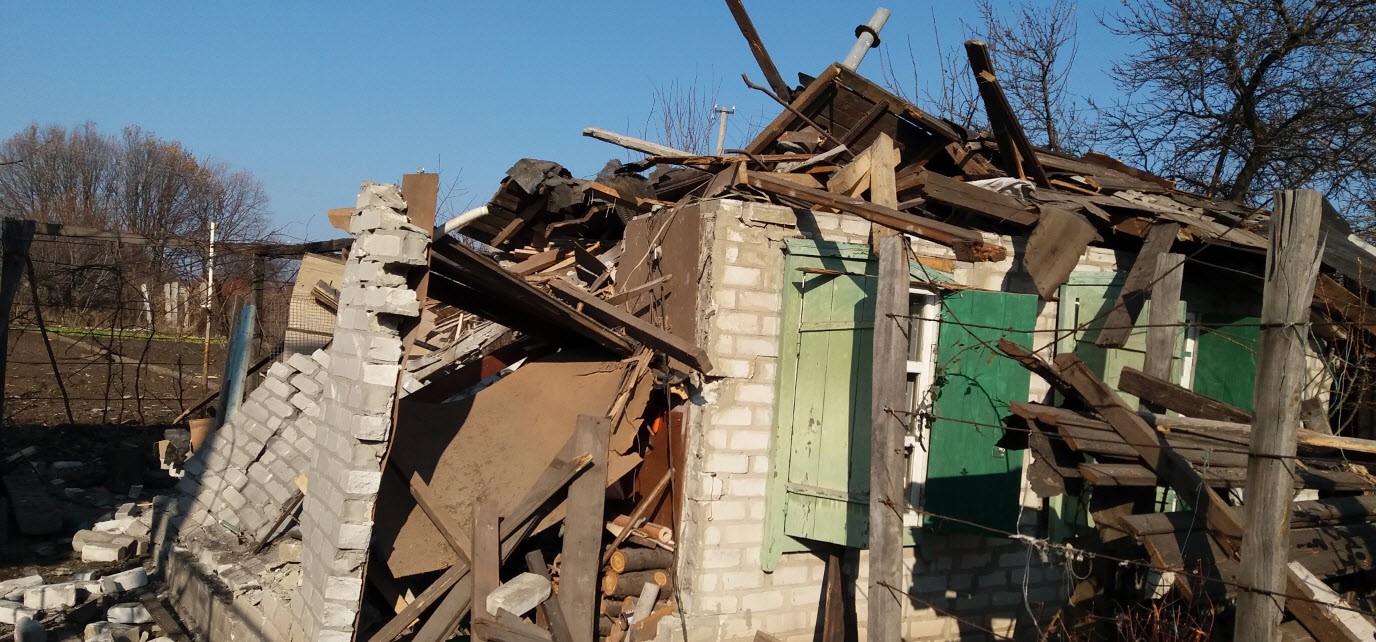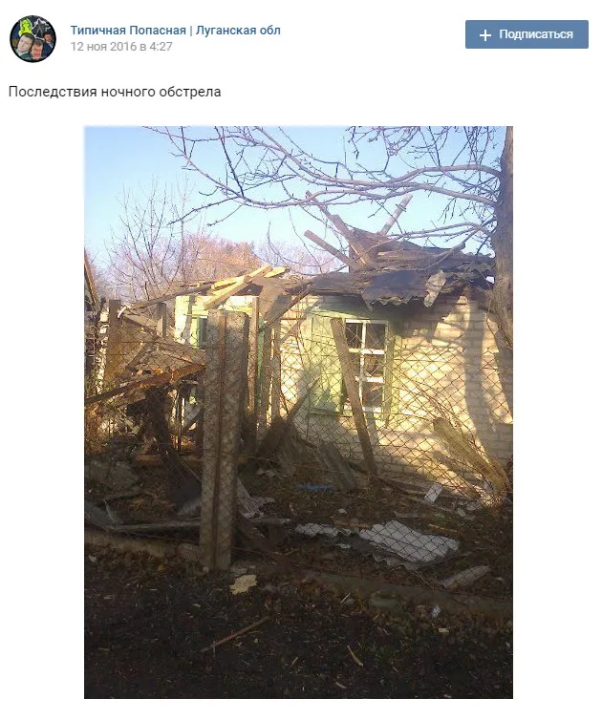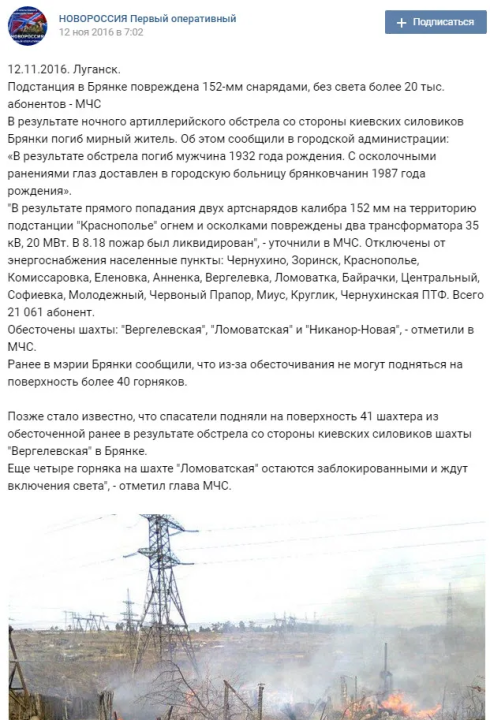One Night of Shelling, Two Stories to Tell
Comparing the aftermath and opposing media coverage of overnight shelling in the Luhansk Oblas
One Night of Shelling, Two Stories to Tell
Share this story

BANNER: Section of photograph from the Luhansk Oblast State Administration press center (source)
In their November 13 daily report, the OSCE Special Monitoring Mission (SMM) to Ukraine described a significant increase in hostilities in the self-proclaimed Luhansk People’s Republic (LNR), with hundreds of artillery shots fired through the night and early morning of November 11–12:
During the evening and night hours of 11–12 November, while in “LPR”-controlled Kadiivka (formerly Stakhanov, 50km west of Luhansk), the SMM heard 94 explosions (outgoing and impacts) assessed as artillery and multiple-launch rocket system (MLRS) fire 5–10km west-north-west, 355 undetermined explosions assessed as artillery and MLRS fire, of which at least 16 were assessed as impacts, 26 outgoing rounds of 152mm artillery fire and respective impacts, and 25 were explosions of MLRS rounds, at distances 5–15km west-south-west, 180 explosions assessed as impacts of artillery rounds of unknown calibre, 150 outgoing explosions of artillery rounds of unknown calibre, 100 explosions (outgoing and impacts) assessed as artillery of unknown calibre, and 13 undetermined explosions all at distances ranging 5–20km north, west-south-west, west and west-north-west. On 13 November, while in Kadiivka, the SMM heard 17 undetermined explosions approximately 10km west-south-west and south-west.
Clearly, there was shelling from both the Ukrainian and separatist forces overnight — as the OSCE observed sequential incoming and outgoing artillery fire. However, the OSCE is limited in only reporting its neutral observations, without assigning blame unless they directly, visually observe an incident. By looking at the available open source materials, what can we say were the actual results of these events observed by the OSCE, and how were they covered in Ukrainian and Russian/separatist media? We will compare the consequences of the overnight shelling in the Ukrainian-controlled town of Popasna and separatist-controlled town of Bryanka, where both sides caused significant damage. Furthermore, we will analyze how the media outlets of Ukraine and the self-proclaimed Luhansk People’s Republic covered the events, and how the journalistic practices differ.
Separatist shelling of Ukrainian-controlled Popasna
Much of the Ukrainian media coverage of the overnight artillery fire of November 11 and 12 focused on damage to the town of Popasna (Popasnaya in Russian). This town is located about 20km west-northwest of the OSCE monitors, putting it well within range of the reported outgoing artillery fire reported in the November 13 daily report. Reports from local civilians on a Popasna Vkontakte community confirm heavy artillery fire that night, and resulting damage to a home on the outskirts of the town. Along with the severe damage to homes on the outskirts of Popasna, electricity lines were damaged. However, there were no reported casualties.
The most cited report in Ukrainian media appeared on the Facebook page and press center website for the Luhansk Oblast State Administration (Луганська обласна державна адміністрація). There are other types of coverage of the incident and surrounding events that have varying degrees of effectiveness and resonance, as seen in the following survey of various Ukrainian media outlets:
— Telekanal Donbas went to the scene of the damaged house and filmed a segment on location, interviewing locals.
— In web reports, RBC Ukraine, Interfax Ukraine, Ukrainska Pravda, and 112 Ukraine cited the Luhansk Oblast State Administration’s Facebook report in its article, without any original photographs or videos from the shelling.
— 5 Kanal, Censor.net, and UkrInform cited the Luhansk Oblast State Administration’s press center’s article on the attack, including photographs of the damage.
— UNIAN used a photograph that supposedly showed a residential house after being shelled by separatists, but the photograph was actually over a year old. They cited the Luhansk Oblast State Administration’s Facebook report.
On Ukrainian corners of social media, the photographs of the damage were the most resonant form of spreading information on the attack.
Последствия ночного обстрела г.Попасная
Падало на окраине города с трех ночи до полчетвертого.#Попасная pic.twitter.com/8tDAoHdUkR— Хуевая Попасная (@hu_popa) November 12, 2016
These photographs also appeared on the popular Vkontakte community group “Typical Popasnaya” in the morning of November 12.

Overall, it is clear that there are relatively few original sources for information on this shelling — a local report with a few photographs, a television channel interviewing the victims soon after, and a few other related reports. Compared to some of their separatist counterparts — as described in the next section — the Ukrainian media is less emotional or sensational in their reports on the damage from shelling, focusing more on referring to authority figures (military figures, soldiers) and providing a more general overview of the situation. However, the news broadcasts and reports are still clearly ideological, most obvious in the frequent use of charged terms such as “terrorist.”
DFRLab spoke with Bogdan Pilenko, a frontline correspondent with 112 Ukraine reporting on the Ukrainian Conflict, including from Popasna soon before the November 11–12 shelling. He described how there are some consistent restrictions for Ukrainian journalists with front-line reporting, such as not revealing positions of the Ukrainian military, or showing the faces of soldiers who do not explicitly allow it. A major controversy erupted around the online television channel Hromadske concerning these transgessions, after a dispatch from Avdiivka reportedly showed the faces and positions of Ukrainian soldiers. When it comes to particularly emotional or disturbing content, he says that he thinks it is important to show interviews with people living in the warzones, as it “helps people who live in districts without war to understand that war is in your country, because in the two-and-a-half years after war has come to Ukraine, some people have forgotten about it.” However, there are still decency standards and restrictions as a national television channel — for example, no corpses or civilian casualties are to be shown on a broadcast, unless they are properly covered.
Ukrainian shelling of separatist-controlled Bryanka
On the same night when separatists shelled Popasna, the Ukrainian military conducted artillery shellings that caused damage in Bryanka, a separatist-controlled city just south of the OSCE monitors positioned in Kadiivka (Stakhanov), and about 25km southeast of Popasna. While the damage in Bryanka was similar to that seen in Popasna — severely damaged homes and a disruption in electrical services — the shelling in Bryanka resulted in more severe electrical outages, and two civilian casualties, including one death. According to Luhansk separatist administrative sources, the most significant damage came when shells hit a house №7 on ulitsa Svobody, and house №8 on ulitsa Oboronnoy, along with damage to an electrical substation.
Unlike Ukrainian media, which has a variety of relatively established television and web news publications, most separatist media consists relatively new web startups, along with fringe nationalist and sensationalist news outlets, such as ANNA News and LifeNews.
— Pro-separatist web video outlet News-Front published a video [extremely graphic] from the scene of a shelled home in Bryanka. Compared to the Ukrainian coverage of the shelling of Popasna, this video is far more emotionally charged — though, with a dead civilian, this is not entirely a result of editorial decisions on the part of News-Front. Along with a civilian yelling at an OSCE monitor at the scene and the description of “the Ukrainian punishers” in the video title, the News-Front crew films a corpse as it is being uncovered at the shelling site.

— The Abkhazian, pro-Russian/separatist news outlet ANNA News also filmed from Bryanka, focusing on the damage on a home and interviewing a local civilian. The man describes how he woke up at around 3:30am from an artillery strike outside of his home. He points to where the shell seems to have come from, corresponding with a filmed artillery crater. The video broadcast also focuses on the damage from the shell fragments on nearby property.
— ANNA News also published a segment on the loss of power in Bryanka after the November 11–12 overnight shelling damaged an electrical substation.
— Separatist television channel TK Novy Kanal Novorossii (Television Channel “New Channel of Novorossiya”) filmed the damage from overnight shelling in Bryanka in the Krasnopolye area and interviewed witnesses. New Channel of Novorossiya also interviewed local officials regarding a loss of electricity after an electrical station was damaged from overnight shelling, along with a local doctor. Compared with the Ukrainian media coverage, this report was closer to the Telekanal Donbas coverage with on-the-scene reporting and interviews with locals, but with more ideologically charged content.
— The LNR Ministry of Emergency Situations published an interview and information regarding the loss of electrical power in Bryanka following the November 11–12 overnight shelling. The ministry’s statements were published in separatist and Russian media.

— In print reports on the web, the publication LNR Today (lnr.today) reported about the death of a 29-year-old in Bryanka and an injury to an 80-year-old pensioner due to the overnight shelling. This report came from the head of the Bryanka city administration in comments to Lugansk 1. Other Russian and separatist media outlets covered the statements from the regular briefings of separatist military officials regarding the Bryanka shelling, similar to the daily ATO reports from the Ukrainian military.
— A wide variety of information was available on social media, as many separatist news outlets put a greater focus on news platforms on Vkontakte and Odnoklassniki than their Ukrainian counterparts. For example, popular photographs are videos were shared on the Odnoklassniki group “Anti-ATO. Information from the commanders of Novorossiya” and the Vkontakte group “NOVOROSSIYA First operative.” While Twitter and Facebook are quite popular among Ukrainians sharing news about the war, Vkontakte and Odnoklassniki are utilized more among separatist and Russian nationalist news outlets.

Conclusions
Through an analysis of the social media, local reports, and media coverage of the overnight events of November 11–12, we can piece together the aftermath of the events described by the OSCE monitors:
— One person died from overnight shelling in separatist-controlled Bryanka. At least one other person was injured, with unconfirmed reports of additional non-lethal injuries.
— Many (likely thousands of civilians) were left without electricity in and around Bryanka after an electrical substation was damaged by overnight shelling from Ukrainian forces.
— In the outskirts of Ukrainian-controlled Popasna, numerous homes were levelled due to separatist shelling. No injuries or fatalities were reported. Electrical service was also disrupted in the area.
Additional events took place in other towns around the area, but the above events were the main outcomes covered in available open source materials. The results in the two towns are not perfectly analogous, with the heavier toll in Bryanka, but we can still parse out the trends and behaviors of Ukrainian and separatist media in covering the ongoing war in the Donbas.
For both sides, social media is a vital method to find and disseminate materials, either for public information or propaganda purposes. Photographs and videos are far more resonant, thus we can observe a focus — especially in separatist circles, where journalists seem to have to greater access and fewer restrictions on the frontlines — on maximizing the amount of visual content. We see this on Russian-language social media platforms Vkontakte and Odnoklassniki more often with separatist media, and primarily English-language platforms Twitter and Facebook with Ukrainian media. Additionally, the television broadcasts in Ukrainian media have far more range and a sense of professionalism than separatist outlets, which are often web-based, newer start-ups, and have different standards regarding explicit content and outwardly ideological slants — though that is not to say that national Ukrainian channels do not use analogous politicized language at times.
In analyzing the true cost of the Ukrainian Conflict, it is vital to not rely on single sources, but instead take neutral observations (daily OSCE SMM to Ukraine reports) alongside local and national reports, even with their apparent biases. By considering a wide range of reports, we can verify individual claims by triangulating photographs, videos, and witness accounts, thus providing a fuller picture of the significant price paid by the civilian populations across the frontlines of the Donbas.

